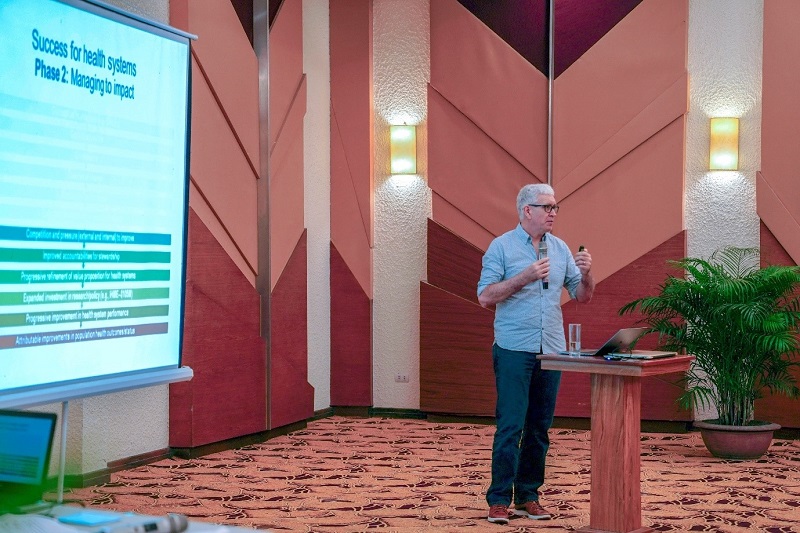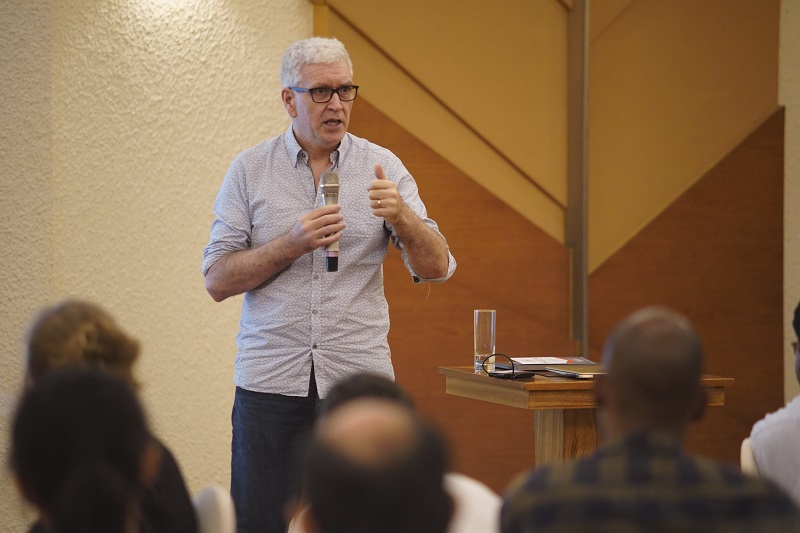Image: Jim at the International Engagement Workshop | Minh Tan
At the 2018 Wellcome International Engagement Workshop, Keynote speaker Jim Lavery, creator of the HELP platform and professor of global health ethics at Emory University, Atlanta, USA, discussed the current state of community and public engagement (CPE) and how it can be developed in the future.
To understand the changes CPE may need to go through to develop as a field, Jim encouraged attendees to “think by analogy”. CPE was compared with the field of health systems performance (HSP), which went through major development and reform in the 1980s and 1990s to become an established and successful field. It could be argued that the position CPE is in now is comparable to the position HSP was in a few decades ago.
So, what can we learn from the development of the HSP field? Jim argues that many of the questions asked of HSP during its development can be applied to CPE now:
- What are the goals of CPE?
- What are we trying to accomplish?
- What is the organising model of CPE?
- What elements or components are necessary to achieve the goals?
- What are their functions?
- How does CPE actually work?
- What actually happens in CPE?
- What are the active mechanisms?
- What outcomes do these mechanisms produce or contribute to?
- How does performance vary by context?
- How does the perception of performance vary with perspective?
- What are the key measures of CPE performance?
- What outcomes are associated with good performance?
- Why are these outcomes considered to be “good”? And by whom?
- What are the indicators of these outcomes?
- Are these indicators currently being tracked and reported and compared in different CPE strategies?
The development of health systems performance as a legitimate field of study, occurred over three main phases:
- Phase 1: Achieving clarity on the conceptual foundations of HSP
- Phase 2: Building the necessary data infrastructure to enable the collection and comparison of HSP data
- Phase 3: Managing the evolution of HSP to achieve impact in improving health systems performance and to improve the focus and responsiveness of health policy at local, national and global levels.

Applying this model to CPE, Jim asked the group whether we have made progress on the goals and rationales for CPE. Have we defined the components of the field? Or created robust models and measures of performance and impact? . Jim argued that we are not yet able to answer these questions adequately for CPE, and to get there we will have to follow a development path similar to HSP. We need to forge consensus on the conceptual foundations of CPE and models of how CPE works. We need to build an evidence base that will allow us to measure performance and make comparisons across programs to gain clarity on the value and purpose of CPE. And we need to manage the development of CPE to ensure it can have a positive impact on the ethics and performance of research programs around the world. The field needs to develop gravity to attract more champions, especially within funding organizations. This will help to elevate the status of CPE from the current perception, by many, that it is ‘fluffy’, and not an integral aspect of many serious research programs, and improve the intelligent integration of CPE into the design and management of research programs.
This may seem like a daunting task – but Jim reassured attendees by highlighting that ten years of thinking and planning went into the first HSP report. The process will take time, and CPE is only in the early stages of its development. To get to the next step, we need sector leaders such as Wellcome to build strategic partnerships and bring others on board. Jim also suggested that we can learn from the private sector about how approaches such as human centred design and customer relationships management have improved the value of a wide range of products and services. Learning from other fields can help us broaden, and deepen our understanding of how CPE can add value in research and communicate this value to decision makers.
Download Jim’s slides here.
---
The content on this page forms part of the online report for the 2018 International Engagement Workshop “Taking it to the Next Level: How can we generate leadership and develop practice in engagement?". To learn more about the workshop, access the rest of the report and browse the video presentations, discussion summaries, and tools, visit the workshop page.

This work is licensed under a Creative Commons Attribution 4.0 International License.


Please Sign in (or Register) to view further.